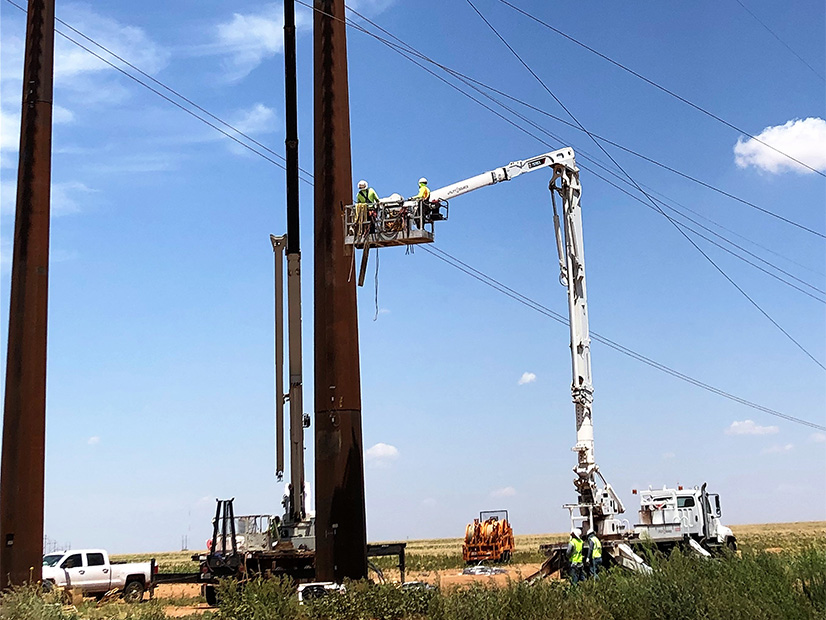FERC has yet to issue a final rule on transmission planning, but supporters of competition for transmission development have said they will appeal it to court if it reimposes a federal right of first refusal (ROFR).
Order 1000 opened up FERC-jurisdictional, regional transmission lines to competition. The commission’s pending Notice of Proposed Rulemaking would pare that back by granting a ROFR as long as an incumbent partners with another firm on a transmission project. FERC also proposed another ROFR for “right-sizing,” which would apply when an ISO or RTO determines it would make sense to increase the capacity on a transmission line rather than just replace it with new infrastructure at the same capacity.
“If they proceed to reinstate these two federal ROFRs, then consumers, without question, will take legal action to oppose [them],” Electricity Transmission Competition Coalition (ETCC) Chair Paul Cicio said in an interview.
ETCC supports expanding transmission infrastructure, but the costs associated with the buildout contemplated by the NOPR’s biggest supporters would be huge, with Cicio saying it could result “in the largest increase in electricity rates in the history of the country.”
“We support competitively bidding all regionally planned transmission projects to lower costs,” Cicio said. “It’s just that simple.”
While ETCC and others, including the Federal Trade Commission and the California Public Utilities Commission, support keeping competition in place, many incumbent transmission owners and their trade groups like the Edison Electric Institute and WIRES argue the policy has not played out as expected in Order 1000 and needs reform to actually build out the grid.
“It was clear after the proposed rule came out that the issue of competitive transmission, and possible restoring rights of first refusal, was highly contentious,” WIRES Executive Director Larry Gasteiger said in an interview. “That follows the history of this competitive transmission process from the get-go from Order 1000. So, I think in a sense, none of that has changed, and the positions over time have probably hardened.”
The two sides of the argument mean FERC cannot possibly satisfy everyone involved, he added.
The debate has led to dueling studies, with one side arguing that opening up transmission to competition saves money, while the other argued that those savings do not always come to fruition and that competition can prevent the kind of collaboration that expands the grid. (See Big Savings for Tx Competition Claimed as FERC Considers a New ROFR.)
For FERC to reimpose the ROFRs, it should have to go through a Section 206 proceeding under the Federal Power Act, in which it must show that it is not working, Cicio said.
“We think that’s going to be hard to do because there’s ample evidence [that] competitively bid projects, regionally planned, have shown substantial reductions of up to 40% in costs and just and reasonable rates,” he added.
The transmission and distribution side of the average customer bill has already grown significantly, Cicio argued: Overall bills have gone up 12.5% annually over the past decade when demand growth was generally flat and, more often than not, natural gas was fairly cheap. The wires part of the average bill has gone from 8% to nearly 30% over the past decade, he said.
“Almost the entire increase in the cost of electricity that consumers are paying is because of a substantial increase and spending in transmission that has not been competitively bid,” Cicio said. He pointed to PJM’s supplemental projects in its transmission planning process, in which projects needed to address local transmission owner needs, such as degrading infrastructure, are not subject to competitive bidding, as they are not regionally planned.
Gasteiger said the experience with competitive transmission has led to more antagonism in the development process. He also noted that cost savings are not always forthcoming.
“It’s actually created an environment where you have a bunch of perverse incentives now,” Gasteiger said. “And the whole goal is to see who can come up with or construct the cheapest bid in order to win the ability to build a project. And what we’re finding is in the aftermath of that, they’re using all kinds of escape clauses to recover cost overruns when they go to build the projects.”
He cited Maine’s experience with the competitively bid Aroostook Renewable Gateway Project to bring onshore wind to market in ISO-NE. The state’s Public Utilities Commission canceled a contract for the project after LS Power said it could no longer build it for its original cost estimate.
FERC has used competition in the generation space for decades, Gasteiger said. While market rules change frequently, competition is a settled issue, he said.
“Electrons are fungible, right?” Gasteiger said. “So, it doesn’t matter what the generation source is for creating electrons. And the structure of that portion of the industry lends itself more towards competition.”
Transmission involves adding new lines to the existing grid, and it helps to be familiar with the local geography, how a new line would fit into the existing system and where existing rights of way are located, he added.
For Cicio, the difference between the two sides of the industry’s experiences with competition comes down to enforcement.
“FERC has not enforced Order 1000,” Cicio said. “No. 1, utilities have taken action to avoid it by doing supplemental projects. And No. 2, they have gone to their state legislatures to put in place ROFRs that thence prevents transmission competition.”



